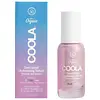What's inside
What's inside
 Key Ingredients
Key Ingredients

 Benefits
Benefits

 Concerns
Concerns

 Ingredients Side-by-side
Ingredients Side-by-side

Butyl Methoxydibenzoylmethane 3%
UV AbsorberEthylhexyl Salicylate 4%
UV AbsorberOctocrylene 8%
UV AbsorberAloe Barbadensis Leaf Juice
Skin ConditioningButyloctyl Salicylate
Skin ConditioningGlycerin
HumectantAmmonium Acryloyldimethyltaurate/Vp Copolymer
CI 77163
Cosmetic ColorantLactobacillus Ferment
Skin ConditioningJasminum Sambac Leaf Cell Extract
MaskingTheobroma Cacao Seed Extract
AntioxidantSchinus Molle Extract
Skin ProtectingWater
Skin ConditioningTitanium Dioxide
Cosmetic ColorantEthyl Ferulate
AntioxidantTropolone
Skin ConditioningMica
Cosmetic ColorantHydroxyacetophenone
AntioxidantPropanediol
SolventButylene Glycol
HumectantSodium Stearoyl Glutamate
Cleansing1,2-Hexanediol
Skin ConditioningCaprylyl Glycol
EmollientEthylhexyl Hydroxystearate
EmollientMaltodextrin
AbsorbentSodium Phytate
Parfum
MaskingButyl Methoxydibenzoylmethane 3%, Ethylhexyl Salicylate 4%, Octocrylene 8%, Aloe Barbadensis Leaf Juice, Butyloctyl Salicylate, Glycerin, Ammonium Acryloyldimethyltaurate/Vp Copolymer, CI 77163, Lactobacillus Ferment, Jasminum Sambac Leaf Cell Extract, Theobroma Cacao Seed Extract, Schinus Molle Extract, Water, Titanium Dioxide, Ethyl Ferulate, Tropolone, Mica, Hydroxyacetophenone, Propanediol, Butylene Glycol, Sodium Stearoyl Glutamate, 1,2-Hexanediol, Caprylyl Glycol, Ethylhexyl Hydroxystearate, Maltodextrin, Sodium Phytate, Parfum
Zinc Oxide 14.14%
Cosmetic ColorantWater
Skin ConditioningPropanediol
SolventC12-15 Alkyl Benzoate
AntimicrobialGlycerin
HumectantIsoamyl Laurate
EmollientButyloctyl Salicylate
Skin ConditioningStyrene/Acrylates Copolymer
Pentylene Glycol
Skin ConditioningCetearyl Alcohol
EmollientPolysorbate 60
EmulsifyingPotassium Cetyl Phosphate
EmulsifyingSodium Hyaluronate
HumectantRubus Idaeus Seed Oil
EmollientGlycine Soja Oil
EmollientOryza Sativa Extract
AbsorbentOryza Sativa Germ Extract
EmollientPanax Ginseng Root Extract
EmollientArgania Spinosa Kernel Oil
EmollientBisabolol
MaskingZea Mays Oil
Emulsifying1,2-Hexanediol
Skin ConditioningButylene Glycol
HumectantCaprylyl Glycol
EmollientSodium Acrylate/Sodium Acryloyldimethyl Taurate Copolymer
Emulsion StabilisingIsohexadecane
EmollientPolyhydroxystearic Acid
EmulsifyingSodium Citrate
BufferingTriethoxycaprylylsilane
Polyglyceryl-3 Diisostearate
EmulsifyingSorbitan Oleate
EmulsifyingCitric Acid
BufferingTocopheryl Acetate
AntioxidantEthyl Hexanediol
SolventPolysorbate 80
EmulsifyingCholecalciferol
Zinc Oxide 14.14%, Water, Propanediol, C12-15 Alkyl Benzoate, Glycerin, Isoamyl Laurate, Butyloctyl Salicylate, Styrene/Acrylates Copolymer, Pentylene Glycol, Cetearyl Alcohol, Polysorbate 60, Potassium Cetyl Phosphate, Sodium Hyaluronate, Rubus Idaeus Seed Oil, Glycine Soja Oil, Oryza Sativa Extract, Oryza Sativa Germ Extract, Panax Ginseng Root Extract, Argania Spinosa Kernel Oil, Bisabolol, Zea Mays Oil, 1,2-Hexanediol, Butylene Glycol, Caprylyl Glycol, Sodium Acrylate/Sodium Acryloyldimethyl Taurate Copolymer, Isohexadecane, Polyhydroxystearic Acid, Sodium Citrate, Triethoxycaprylylsilane, Polyglyceryl-3 Diisostearate, Sorbitan Oleate, Citric Acid, Tocopheryl Acetate, Ethyl Hexanediol, Polysorbate 80, Cholecalciferol
Ingredients Explained
These ingredients are found in both products.
Ingredients higher up in an ingredient list are typically present in a larger amount.
1,2-Hexanediol is a synthetic liquid and another multi-functional powerhouse.
It is a:
- Humectant, drawing moisture into the skin
- Emollient, helping to soften skin
- Solvent, dispersing and stabilizing formulas
- Preservative booster, enhancing the antimicrobial activity of other preservatives
Butylene Glycol (or BG) is used within cosmetic products for a few different reasons:
Overall, Butylene Glycol is a safe and well-rounded ingredient that works well with other ingredients.
Though this ingredient works well with most skin types, some people with sensitive skin may experience a reaction such as allergic rashes, closed comedones, or itchiness.
Learn more about Butylene GlycolButyloctyl Salicylate is a chemical UV filter structurally similar to octisalate. It is a photostabilizer, SPF booster, emollient and solvent. This ingredient helps evenly spread out ingredients.
According to a manufacturer, it is suitable for pairing with micro Titanium Dioxide, Zinc Oxide, and pigments.
Photostabilizers help stabilize UV-filters and prevents them from degrading quickly.
Learn more about Butyloctyl SalicylateCaprylyl Glycol is a humectant and emollient, meaning it attracts and preserves moisture.
It is a common ingredient in many products, especially those designed to hydrate skin. The primary benefits are retaining moisture, skin softening, and promoting a healthy skin barrier.
Though Caprylyl Glycol is an alcohol derived from fatty acids, it is not the kind that can dry out skin.
This ingredient is also used as a preservative to extend the life of products. It has slight antimicrobial properties.
Learn more about Caprylyl GlycolGlycerin is already naturally found in your skin. It helps moisturize and protect your skin.
A study from 2016 found glycerin to be more effective as a humectant than AHAs and hyaluronic acid.
As a humectant, it helps the skin stay hydrated by pulling moisture to your skin. The low molecular weight of glycerin allows it to pull moisture into the deeper layers of your skin.
Hydrated skin improves your skin barrier; Your skin barrier helps protect against irritants and bacteria.
Glycerin has also been found to have antimicrobial and antiviral properties. Due to these properties, glycerin is often used in wound and burn treatments.
In cosmetics, glycerin is usually derived from plants such as soybean or palm. However, it can also be sourced from animals, such as tallow or animal fat.
This ingredient is organic, colorless, odorless, and non-toxic.
Glycerin is the name for this ingredient in American English. British English uses Glycerol/Glycerine.
Learn more about GlycerinPropanediol is an all-star ingredient. It softens, hydrates, and smooths the skin.
It’s often used to:
Propanediol is not likely to cause sensitivity and considered safe to use. It is derived from corn or petroleum with a clear color and no scent.
Learn more about PropanediolWater. It's the most common cosmetic ingredient of all. You'll usually see it at the top of ingredient lists, meaning that it makes up the largest part of the product.
So why is it so popular? Water most often acts as a solvent - this means that it helps dissolve other ingredients into the formulation.
You'll also recognize water as that liquid we all need to stay alive. If you see this, drink a glass of water. Stay hydrated!
Learn more about Water